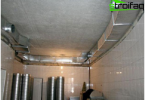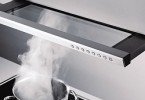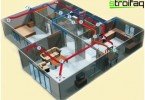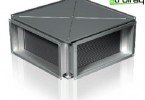Proper ventilation in the bathroom
For some reasons, some utility rooms in a house or apartment are more susceptible to condensation than others, therefore it is advisable to install additional ventilation devices in them. The bathroom is one of these rooms, and insufficient ventilation leads to unpleasant odors and an increase in air humidity, which, in turn, is fraught with settling of condensation on the walls, floor and ceiling, which is a favorable environment for fungi and bacteria. Proper ventilation in the bathroom will save the tiles and furniture from mold, prolong the service of mirrors, eliminate the causes of unpleasant odors.
Content
- Simple methods of exhaust ventilation
- Selection and calculation of exhaust fan power
- Basic rules for installing ventilation
- And what about ventilation in a wooden house?
Simple methods of exhaust ventilation
Simple ventilation in the bathroom by airing or using a passive exhaust ventilation system may not be effective enough. In multi-storey buildings built more than twenty years ago, ventilation systems are gradually polluted and can no longer cope with increasing loads.
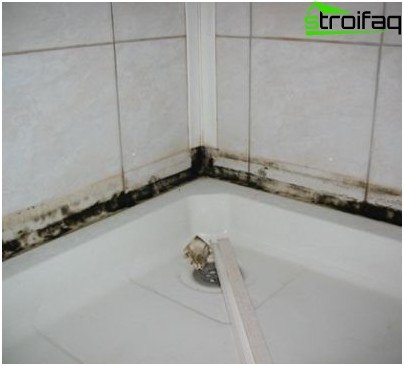
Mold on the tile surface in the bathroom indicates insufficient ventilation
Forcing troubles like a musty smell and mold on the walls will help forced ventilation in the bathroom, which will remove moist air from the bathroom into the common duct and prevent it from returning to the room.
Inadequate ventilation in the bathroom is corrected in several ways. The first, simplest one, which does not require any material or physical expenses, is an open door, which contributes to the constant change of air in the room. This method justifies itself in cases where the aesthetic component of the living space is not decisive. Simply put, if the owners do not care that the bathroom is on display, then this method is ideal. The second method is suitable for those who have already realized the presence of a problem, but are not yet ready for its radical solution, and consists in widening the gap under the door. An increase in the door gap of only 2 cm is quite capable of solving the problem of ventilation of a small bathroom.
Selection and calculation of exhaust fan power
The most effective way is to install ventilation in the bathroom in the form of a compact electric fan that will cope with its task even if only a small clearance remains in the uncleaned system of general ventilation. Wall axial fans are usually used for this purpose. When choosing such a device, first of all, pay attention to:
- Safety, since the fan is an electric device, and the bathroom is a room with high humidity, therefore, protection against ingress of water or steam should be maximum.
- The noise level of the fan, which can annoy the residents of the apartment. You can install a muffler, and if this is not enough, then install soundproof materials inside the duct;
- The power of the exhaust device should optimally correlate with the size of the bathroom and the number of users. If the fan power is not enough, then its installation loses all meaning.
Important! Before you make ventilation in the bathroom, you need to determine the power of the fan. The calculation of the required fan power is carried out according to the formula 6V or 8V, where V is the volume of the bathroom, and 6 and 8 are the coefficients corresponding to the number of people who constantly use the bathroom. The coefficient 8 is used in the calculations if more than 3 people use the bathroom.
Ventilation in the bathroom and toilet can be connected to a light switch and in this case it will work only when it is really necessary. However, not everyone is delighted when a toilet or bath is accompanied by the noise of exhaust ventilation. In this situation, it is best to make a stand-alone switch for the hood and use it when its operation will not disturb anyone.
Basic rules for installing ventilation
Both passive and forced exhaust ventilation in the bathroom should be located:
- At the highest possible height, preferably right under the ceiling;
- As far as possible from a source of fresh air (ideally on the opposite side), otherwise only local ventilation will be provided, practically not affecting other parts of the bathroom;
- Install the fan away from water sources to avoid short circuits..
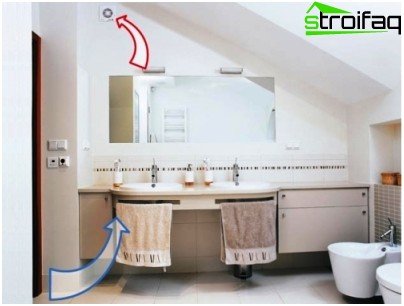
Improperly installed ventilation – most of the air mass remains outside the ventilation zone, and the air entering through the door immediately goes to the ventilation hole
Usually installation of ventilation in the bathroom is not associated with additional difficulties, but it is better to think about installing a fan in advance. In this case, it is possible to hide the wires inside the walls during the repair work. If the work has already been completed and the hood has not been installed, then all the time until the next repair, the bathroom will be “decorated” with wiring leading to the fan.
And what about ventilation in a wooden house?
Ventilation in a private house in the bathroom should be initially included in the project: usually in the bathroom, toilet and kitchen there are hidden ventilation shafts equipped with decorative grilles at the entrance. If the bathroom in a private house is located on the ground floor, then you can get by with normal ventilation using natural convection. However, more and more often private bathrooms have several bathrooms, so forced ventilation must be installed in the bathroom on the top floor of a private house.
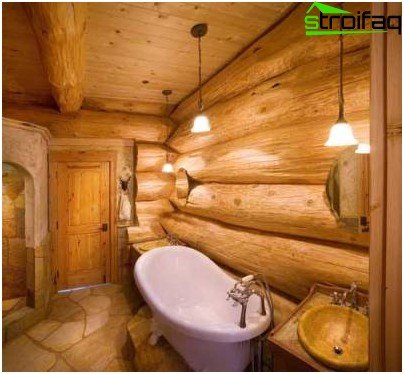
Wet and warm air should be removed from the wooden house as quickly as possible before it has a negative effect on the tree
Ventilation in the bathroom in a wooden house is experiencing serious additional loads due to the characteristics of the material, so completely different requirements are imposed on it. The same applies to bathrooms with wooden furniture. Both wooden walls, furniture, and interior details are very much exposed to high humidity, therefore, when designing a bathroom in a private wooden house, additional ventilation ducts and exhaust ventilation should be provided. It is not recommended to use air conditioners for these purposes, as they strongly dry the air, and constant changes in humidity can lead to cracking of the tree.


